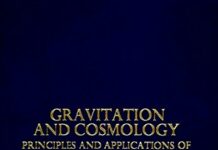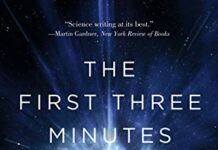
Ebook Info
- Published: 2008
- Number of pages: 616 pages
- Format: PDF
- File Size: 2.50 MB
- Authors: Steven Weinberg
Description
This book is unique in the detailed, self-contained, and comprehensive treatment that it gives to the ideas and formulas that are used and tested in modern cosmological research. It divides into two parts, each of which provides enough material for a one-semester graduate course. The first part deals chiefly with the isotropic and homogeneous average universe; the second part concentrates on the departures from the average universe. Throughout the book the authorpresents detailed analytic calculations of cosmological phenomena, rather than just report results obtained elsewhere by numerical computation. The book is up to date, and gives detailed accounts of topics such as recombination, microwave background polarization, leptogenesis, gravitational lensing,structure formation, and multifield inflation, that are usually treated superficially if at all in treatises on cosmology. Copious references to current research literature are supplied. Appendices include a brief introduction to general relativity, and a detailed derivation of the Boltzmann equation for photons and neutrinos used in calculations of cosmological evolution. Also provided is an assortment of problems.
User’s Reviews
Reviews from Amazon users which were colected at the time this book was published on the website:
⭐Here I am in the year 2018. Cosmology, the monograph authored by Steven Weinberg, is the last book on the topic I purchased and studied. That purchase was made 2008. Between then and now (between 2008 and 2018) we have witnessed a plethora of speculation, the multiverse being one example. I confess, such speculation (multiverse and others) had turned me off to the topic. I revel in comparison of experimental numbers to theoretical predictions. Thus, my affinity for two classics of Cosmology: Physical Cosmology (James Peebles) and Cosmology (Steven Weinberg). Why is that so ? Numbers from experiment weighed against theoretical predictions are the leitmotif of the two books. Steven Weinberg has written another winning exposition.(1) Weinberg begins with “distance indicators.” Read: “the agreement between the values of Hubble Constant provided by these very different methods will serve to validate the cosmological assumptions made in the analysis of cosmic microwave background.” (page 31). Before “turning to dynamical theory” we are reminded of the variety of different measures of distance (page 33). Dynamical theory alerts the reader to the importance of General Relativity for the subject. Read: “Lorentz invariance requires that in locally inertial coordinate systems the energy-momentum tensor of the vacuum must be proportional to the Minkowski metric.” (page 40). This is your first view of Vacuum Energy.(2) We remain in chapter one: Expansion of the Universe. Quintessence…”a time-varying vacuum energy” (page 89). Nearly ten pages of exposition where “it may be illuminating to work out the consequences of this one specific model of quintessence.” Excellent Pedagogy !(3) Second Chapter–Cosmic Microwave Radiation Background. This is first brush with the topic, it recurs, time and time again. Grab one of those Modern Physics textbooks and brush-up on “blackbody radiation.” (Richtmyer and Kennard). Return to Steven Weinberg for more specialized applications–anisotropies and fluctuations–these will be analyzed. Fourier integrals, Legendre polynomials, Gaussian distributions, all of that and more will be utilized. Conclude with a comparison between experiment and theory.(4) Before reading chapter three–Early Universe–study Weinberg’s 1977 book, The First Three Minutes. Then, return. Now, avail yourself of the fine exposition regards “Cold Dark Matter” (page 185). Read: “if the particles that make up most of the mass of the Universe are not Baryons, what are they ? “Wimps, Supersymmetry and Axions, these things–and more–will occupy the next fifteen pages…as prelude to….(5) Inflation. Read: “the details of inflation are unknown…it has had one significant experimental success, a prediction of some of the properties of the fluctuations in the cosmic microwave background and large-scale structure.” (page 202). Learn of Flatness (“least convincing argument for inflation”), Horizons (“inflation provides an explanation”) and Monopoles.(6) Revisit fluctuations. General relativity (field equations) is front-and-center. Revisit Fourier analysis and “Whatever happens during Inflation, if the Universe subsequently spends sufficient time in a state of local thermal equilibrium with no non-zero conserved quantities, then the perturbations become adiabatic–and, they remain adiabatic subsequently–even when the conditions of thermal equilibrium are no longer satisfied.” That statement says a lot ! The ensuing chapter six will provide more details of cosmological fluctuations. Before study of chapter six, a refresher of hydrodynamic, kinetic and Boltzmann equations proves useful.(7) Next, a tough chapter seven. The chapter revisits the anisotropies in the cosmic background radiation. Read: “The general agreement of theory and observation, both for microwave background anisotropies alone and for background anisotropies in conjunction with other observations, goes far to confirm the general assumptions of the cosmological model, including cold dark matter and dark energy, that we have been using.” (page 362). A nice thirty-page exposition on polarization concludes the chapter: “polarization due to scattering by free electrons” which may become more important “in revealing the effects of gravitational waves produced during inflation.” (pages 370-400).(8) Read from chapter nine, Gravitational Lenses: “For cosmology, the most promising application of gravitational lenses probably lies in surveys of weak lensing, the study of distortion of distant galaxies by numerous small deflections of light as it passes from galaxies to us through a slightly inhomogeneous distribution of matter.(9) The final chapter ten revisits fluctuations. Or, more accurately, inflation as the origin of cosmological fluctuations. Read: “Why should the action of gravitation contain only the Einstein term, and not other generally covariant terms with more than two derivatives of the metric ? And, why should the action of the standard electroweak model or quantum chromodynamics contain only renormalizable terms ? ” Learn about it in these pages.(10) There are appendices: one is survey of general relativity (eighteen pages) and Newtonian cosmology. Another (appendix H) outlines material needed for understanding of Boltzmann equation (as prelude to chapter six and seven). The Cosmology text of Weinberg was my latest serious look into cosmology.No matter what the future holds, because Weinberg presents experimental numbers alongside theoretical models, his book remains invaluable. Without such interplay between experiment and theory, I am hard-pressed to call the subject physics.
⭐I admire this book, and its author. I had read his popular account The First Three Minutes, but I wanted mathematics to aid my understanding. I’m no physicist, nor am I a mathematician, but somehow equations so often seem to make certain things more understandable than words. Now, let’s be clear: 60% or so of the tome is beyond me. But I’m OK about that. I got what I wanted from the remainder, discovering some maths that made his ideas (& those of other writers like Alan Guth) much clearer to me. Given that it was written to be suitable for a 2 semester graduate school course I have no hard feelings about not being on top of most of it. I got enough to understand where he was coming from.His scholarship is prodigious. Beginning with Einstein & those who proffered solutions to his landmark equations, right up to inflation and then the mighty (empirical) discovery of the 90s that the expansion of the universe is accelerating and it’s due to dark energy. It is all so breathtaking. This man won a Nobel Prize back in the 1970s (I think it was) in a completely different field of physics. Now he moves sideways and demonstrates (in his 80s) that he is all class, a cutting edge scholar of intimidating proportions.I used to tell my first years that the BIG questions we all should care about come from cosmology (how the whole box & dice began & evolved), biology (how life formed and evolved), and from our discipline, anthropology, (for how we humans evolved and changed). This book confirms me in that belief.The only reason I have not given it 5 stars is that as an outsider who is not with all the esoterica, I feel unqualified to say unreservedly, this is a 5 star book. I hope the author isn’t offended with that reason; 4 is still a distinction grade.
⭐I am conducting intense research on astrophysics and cosmology as a self educating endeavor. This is not an ideal book for beginners in this field. It is an outstanding and effectively presented gathering of current astrophysics and cosmology studies into one book. A friend recommended Steven Weinberg’s book on Cosmology to me, among several other books, as a reputable source in the field. Weinberg’s book is widely used in universities to teach students in physics and cosmology. I enjoyed reading the book and being introduced to various equations, studies, and branches of ideology in the field. It is apparent that this science is still developing, theories get overridden by new and better theories, but observations remain constant and stand the test of time. At times, some of the equations were confusing and misleading, but after additional research from other sources, I was able to make some sense of this incomprehensible material, and try to understand why our scientists are leading us down their path, which in my view is not necessarily the right road. Always remember that math does not control how the universe exists, it only tries to capture and replicate it in numbers and equations. Same applies with math trying to emulate how nature operates and functions, even in the micro world of quantum physics. Question everything, and most of all do your own research; do not trust the word of our greatest scientists as absolute, for they too are as human as you and I, and are prone to mistakes. The universe does not obey them, the universe is indifferent, as stated by Carl Sagan.
⭐In the 1970s Weinberg wrote a 2-volume work called Gravitation & Cosmology, Principles & Applications of the General Theory of Relativity. Since then he’s been busy (winning the Nobel prise, for one thing) and now he’s come back and provided a supplementary volume as an update. He says the Gravitation bit doesn’t need updating as the theory hasn’t changed much but the Cosmology bit has changed substantially over the 30 or so years since G&C (as he calls it). You can read this as a stand-alone without buying G&C but the introduction to tensor calculus at the start is rather short compared to the detailed exposition in G&C. Also, for some of the proofs he refers back to G&C. The amount of detail here is amazing and his commentary is very illuminating. He really does explain it all well. I love it and will go back to it again and again.
⭐Well, it’s a pretty heavy mathematical coverage on the subject…not many pretty pictures but clearly a detailed, comprehensive and very well structured book in the same vein as the quantum theory of field by the same author.I’m wadding through pretty slowly just for recreation…not easy to follow in detail but gives a fascinating window on the sort of lengths that physicists are going to compare experimental data with theoretical models
⭐Testo fondamentale, ottima edizione. Compravendita perfetta.
⭐
⭐Another great book by Steven Weinberg. A very thorough and methodical presentation with heaps of detailed explanations. Weinberg incorporated all the latest observational data and research up to the date of publication.
⭐We have to recognize the books with excellent printing quality features. This is one!!! A little bit expensive though it surely deserves the effort.
Keywords
Free Download Cosmology in PDF format
Cosmology PDF Free Download
Download Cosmology 2008 PDF Free
Cosmology 2008 PDF Free Download
Download Cosmology PDF
Free Download Ebook Cosmology




